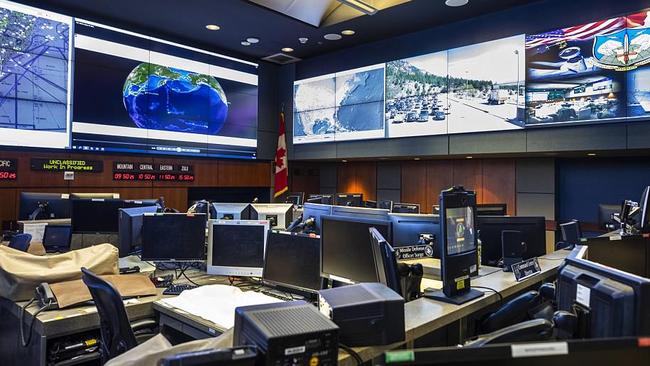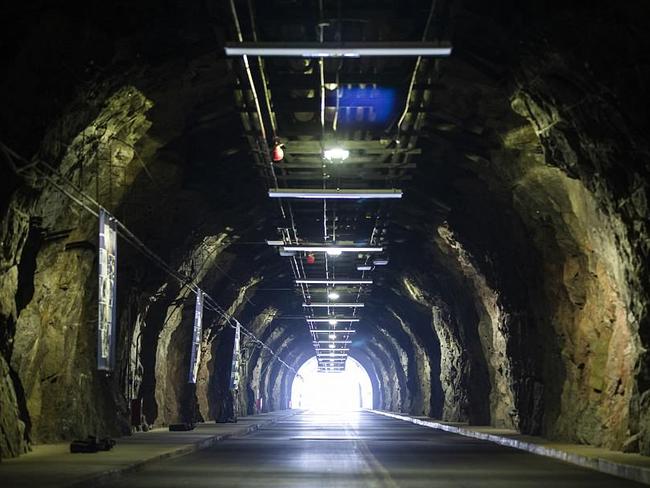‘The most secure facility in the world’: The former Cold War control centre built in a mountain
THE Cold War ended long ago but a secret base built inside a mountain in Colorado remains active — and it’s designed to survive a nuclear attack.

A QUARTER of a century has passed since the end of the nuclear standoff between the United States and the former Soviet Union, but the famous US military command centre inside Colorado’s Cheyenne Mountain is still alive, tracking new threats from new enemies.
The US blasted a warren of tunnels out of the mountain’s hard granite in the 1960s so officers of the North American Aerospace Defence Command, or NORAD, could survive a nuclear attack.
Although NORAD called off its “nuclear watch” in 1992 after the Soviet Union disintegrated, Cheyenne Mountain is still teeming with electronics and personnel watching for terrorist attacks and cyber assaults as well as missiles.
Saturday is the 60th anniversary of NORAD, a unique bi-national command created by the US and Canada to protect the skies over both nations. To mark the occasion, NORAD has offered a sneak peak into the mountain base.


‘THE MOST SECURE FACILITY IN THE WORLD’
The bunker lies 610m under Cheyenne Mountain outside Colorado Springs, Colorado. It can be sealed off by two giant blast doors made of concrete and steel, each 1m thick and weighing 21 tonnes.
“We like to say it’s the most secure facility in the world,” deputy director of the base Steve Rose said.
The heart of the complex is a grid of six tunnels up to 12m wide and three stories high. They hold 15 connected buildings made of steel plates, riding on massive coil springs to absorb the shock of a nuclear blast or earthquake.
The granite and steel also protect electronics from destructive pulses of electromagnetic energy that nuclear explosions produce. Asked whether Cheyenne Mountain is vulnerable to more powerful modern nuclear warheads, Mr Rose answered indirectly: “I don’t think we would be open if it was.”


WHY NORAD IS IN COLORADO
The military put NORAD in Colorado because it is near the centre of the continent, far from Soviet bomber bases and missile launchers, NORAD’s deputy historian Brian Laslie said.
The first command centre was at the now-decommissioned Ent Air Force Base in Colorado Springs.
By the early 1960s, it was clear Ent would not survive a nuclear attack, so work began on burrowing into the mountain, Dr Laslie said. The room is surprisingly small, about 12m square. Eight big video screens line the walls. Soft lighting, muted colours and sound-muffling surfaces give the room a hushed, sombre feel.
CHEYENNE MOUNTAIN IS NOW THE BACKUP
In 2008, the military opened a bigger command centre at Peterson Air Force Base in Colorado Springs, saying Cheyenne Mountain was costly to run and that the primary threats at the time, North Korea and Iran, did not have missiles capable of reaching Colorado.
Cheyenne Mountain became the alternate command centre, but operations regularly return there for a few days at a time to make sure the room and its staff are ready in the event of a crisis.
Mr Rose, the base deputy director, rejected the notion that Cheyenne Mountain is a relic.
“Couldn’t be farther from the truth,” he said, noting the mountain is fully occupied by a permanent NORAD contingent as well as commands for cyber, intelligence and space surveillance. “A lot of the other areas, I can’t talk about,” he added.


HOW NORAD HAS CHANGED IN THE 21ST CENTURY
After the Soviet Union collapsed, “NORAD had a bit of a slump as far as the focus of the mission,” senior command centre officer Colonel Travis Morehen said.
The 9/11 terrorist attacks abruptly changed that. Before 9/11, NORAD watched only for external threats. After the terrorists turned domestic airliners into weapons, NORAD began peering inward as well, monitoring civilian air traffic for potential threats.
NORAD regularly launches fighter jets to intercept private aircraft that stray into restricted airspace, including areas where the President is travelling. It is usually a civilian who didn’t read official notices, Col Morehen said.
BIG AND LITTLE MOMENTS IN NORAD HISTORY
In 1979 and 1980, NORAD computer glitches produced false alarms about incoming missiles. Each time, the problem was discovered quickly.
Cheyenne Mountain is an alluring setting for science fiction. It was depicted in the 1983 movie WarGames starring Matthew Broderick, the Terminator movies (it was the installation site for Skynet), Interstellar, and in the Stargate TV series, among others.
It takes 45 seconds for built-in hydraulic machinery to close the blast doors. If the hydraulics fail, two people can close them by hand. One door usually remained shut at all times during the Cold War. Since then, commanders ordered them closed only once, on 9/11.
NORAD is also known worldwide for its “NORAD Tracks Santa” operation, fielding calls from children on Christmas Eve asking where Santa is. However, the operation has always been run out of Ent or Peterson Air Force Base in Colorado Springs, never Cheyenne Mountain, Dr Laslie said.
— AP



